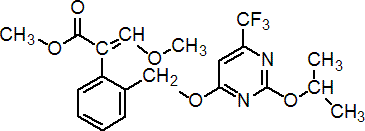|
fluacrypyrim
Acaricide

NOMENCLATURE
Common name fluacrypyrim (BSI, pa ISO)
IUPAC name methyl (E)-2-{a-[2-isopropoxy-6-(trifluoromethyl)pyrimidin-4-yloxy]-o-tolyl}-3-methoxyacrylate
Chemical Abstracts name methyl (aE)-a-(methoxymethylene)-2-[[[2-(1-methylethoxy)-6-(trifluoromethyl)-4-pyrimidinyl]oxy]methyl]benzeneacetate
CAS RN [229977-93-9] Development codes NA-83
PHYSICAL CHEMISTRY
Mol. wt. 426.4 M.f. C20H21F3N2O5 Form White odourless solid. M.p. 107.2-108.6 °C V.p. 2.69 ´ 10-3 mPa (20ºC, gas saturation method) KOW logP = 4.51 (pH 6.8, 25 ºC) S.g./density 1.276 Solubility In water 3.44 ´ 10-4 g/l (pH 6.8, 20 ºC). In dichloromethane 579, acetone 278, xylene 119, acetonitrile 287, methanol 27.1, ethanol 15.1, ethyl acetate 232, n-hexane 1.84, n-heptane 1.60 (all in g/l, 20 ºC). Stability Stable at pH 4 and 7; DT50 574 d (pH9). Aqueous photolysis DT50 26 d.
COMMERCIALISATION
Manufacturers Nippon Soda
APPLICATIONS
Mode of action Acaricide with contact and stomach action. Uses Control of Panonychus at 10 g/100 l for citrus, Panonychus and Tetranychus at 15 g/100 l for apples and pears. Formulation types SC. Selected products: 'Titaron' (Nippon Soda)
OTHER PRODUCTS
Mixtures: 'Oonata' (+ chlorfenapyr) (Nippon Soda)
MAMMALIAN TOXICOLOGY
Oral Acute oral LD50 for male and female rats >5000 mg/kg. Skin and eye Acute percutaneous LD50 for male and female rats >2000 mg/kg. Weakly irritating for eyes, non-irritating for skin (rabbits). Inhalation LC50 (4 h) for male and female rats >5.09mg/l. NOEL NOEL (24 months) for male rats 5.9 mg/kg b.w., for female rats 61.7 mg/kg b.w; (18 months) for male mice 20 mg/kg b.w., for female mice 30 mg/kg b.w; (12 months) for male and female dogs 10 mg/kg b.w. ADI 0.059 mg/kg b.w. (Japan)
ECOTOXICOLOGY
Birds Acute oral LD50 for bobwhite quail >2250 mg/kg; dietary LC50 for bobwhite quail >5620 ppm. Fish LC50 (96 h) for carp 0.195 ppm. Daphnia LC50 (48 h) 0.094 ppm. Algae EbC50 (72 h) for Selenastrum capricornutum 0.0173 ppm; ErC50 (72 h) for Selenastrum capricornutum 0.14 ppm. Bees LC50 (oral ) >300 ppm; LD50 (contact) >10 mg/bee. Worms LC50 for earthworms 23 mg/kg soil. Other beneficial spp. No effect on Agistemus exsertus at 400ppm.
|